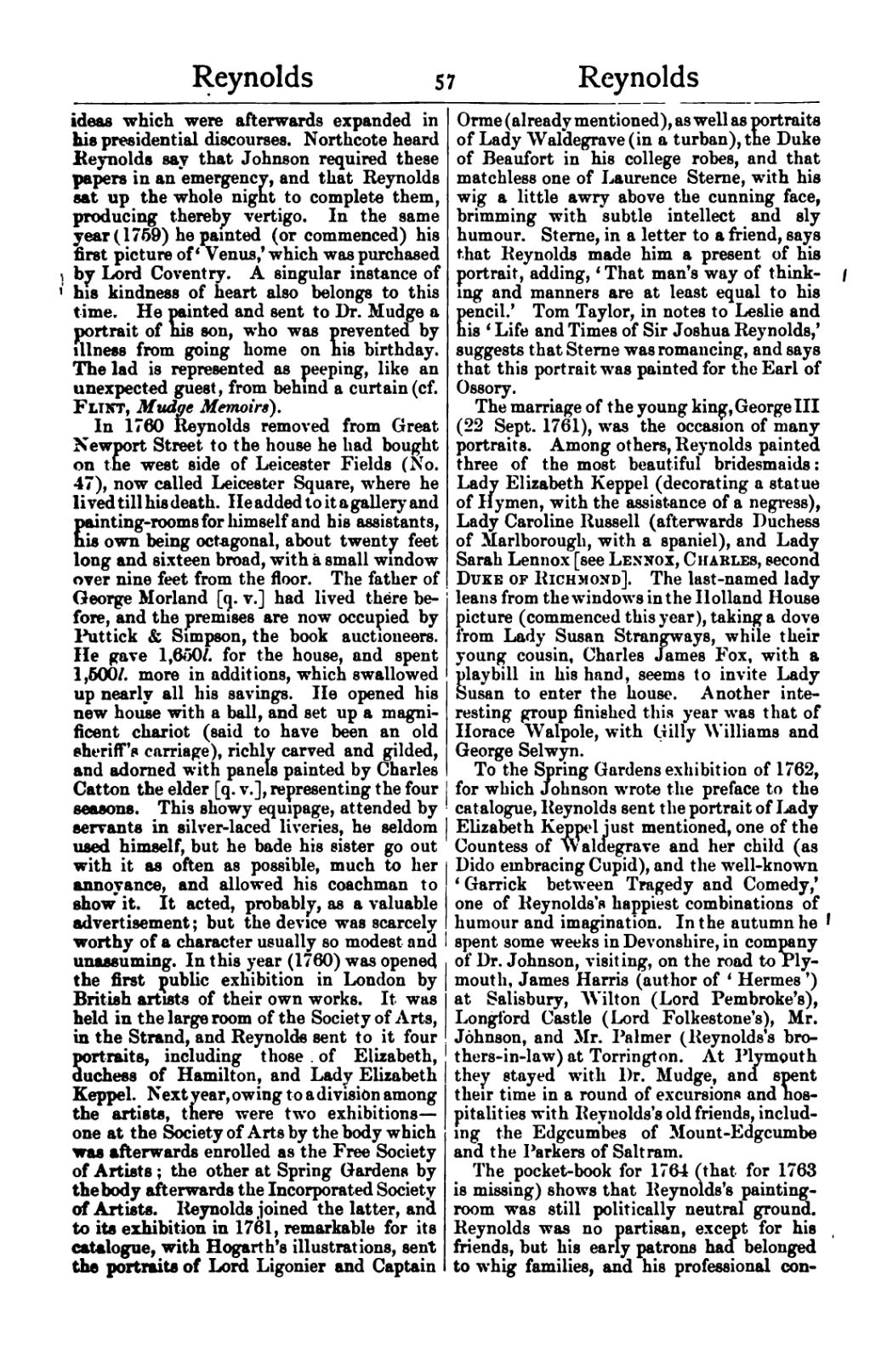ideas which were afterwards expanded in his presidential discourses. Northcote heard Reynolds say that Johnson required these papers in an emergency, and that Reynolds sat up the whole night to complete them, producing thereby vertigo. In the same year (1759) he painted (or commenced) his first picture of ‘Venus,’ which was purchased by Lord Coventry. A singular instance of his kindness of heart also belongs to this time. He painted and sent to Dr. Mudge a portrait of his son, who was prevented by illness from going home on his birthday. The lad is represented as peeping, like an unexpected guest, from behind a curtain (cf. Flint, Mudge Memoirs).
In 1760 Reynolds removed from Great Newport Street to the house he had bought on the west side of Leicester Fields (No. 47), now called Leicester Square, where he lived till his death. He added to it a gallery and painting-rooms for himself and his assistants, his own being octagonal, about twenty feet long and sixteen broad, with a small window over nine feet from the floor. The father of George Morland [q. v.] had lived there before, and the premises are now occupied by Puttick & Simpson, the book auctioneers. He gave 1,650l. for the house, and spent 1,500l. more in additions, which swallowed up nearly all his savings. He opened his new house with a ball, and set up a magnificent chariot (said to have been an old sheriff's carriage), richly carved and gilded, and adorned with panels painted by Charles Catton the elder [q. v.], representing the four seasons. This showy equipage, attended by servants in silver-laced liveries, he seldom used himself, but he bade his sister go out with it as often as possible, much to her annoyance, and allowed his coachman to show it. It acted, probably, as a valuable advertisement; but the device was scarcely worthy of a character usually so modest and unassuming. In this year (1760) was opened the first public exhibition in London by British artists of their own works. It was held in the large room of the Society of Arts, in the Strand, and Reynolds sent to it four portraits, including those of Elizabeth, duchess of Hamilton, and Lady Elizabeth Keppel. Next year, owing to a division among the artists, there were two exhibitions—one at the Society of Arts by the body which was afterwards enrolled as the Free Society of Artists; the other at Spring Gardens by the body afterwards the Incorporated Society of Artists. Reynolds joined the latter, and to its exhibition in 1761, remarkable for its catalogue, with Hogarth's illustrations, sent the portraits of Lord Ligonier and Captain Orme (already mentioned), as well as portraits of Lady Waldegrave (in a turban), the Duke of Beaufort in his college robes, and that matchless one of Laurence Sterne, with his wig a little awry above the cunning face, brimming with subtle intellect and sly humour. Sterne, in a letter to a friend, says that Reynolds made him a present of his portrait, adding, ‘That man's way of thinking and manners are at least equal to his pencil.’ Tom Taylor, in notes to Leslie and his ‘Life and Times of Sir Joshua Reynolds,’ suggests that Sterne was romancing, and says that this portrait was painted for the Earl of Ossory.
The marriage of the young king, George III (22 Sept. 1761), was the occasion of many portraits. Among others, Reynolds painted three of the most beautiful bridesmaids: Lady Elizabeth Keppel (decorating a statue of Hymen, with the assistance of a negress), Lady Caroline Russell (afterwards Duchess of Marlborough, with a spaniel), and Lady Sarah Lennox [see Lennox, Charles, second Duke of Richmond]. The last-named lady leans from the windows in the Holland House picture (commenced this year), taking a dove from Lady Susan Strangways, while their young cousin, Charles James Fox, with a playbill in his hand, seems to invite Lady Susan to enter the house. Another interesting group finished this year was that of Horace Walpole, with Gilly Williams and George Selwyn.
To the Spring Gardens exhibition of 1762, for which Johnson wrote the preface to the catalogue, Reynolds sent the portrait of Lady Elizabeth Keppel just mentioned, one of the Countess of Waldegrave and her child (as Dido embracing Cupid), and the well-known ‘Garrick between Tragedy and Comedy,’ one of Reynolds's happiest combinations of humour and imagination. In the autumn he spent some weeks in Devonshire, in company of Dr. Johnson, visiting, on the road to Plymouth, James Harris (author of ‘Hermes’) at Salisbury, Wilton (Lord Pembroke's), Longford Castle (Lord Folkestone's), Mr. Johnson, and Mr. Palmer (Reynolds's brothers-in-law) at Torrington. At Plymouth they stayed with Dr. Mudge, and spent their time in a round of excursions and hospitalities with Reynolds's old friends, including the Edgcumbes of Mount-Edgcumbe and the Parkers of Saltram.
The pocket-book for 1764 (that for 1763 is missing) shows that Reynolds's painting-room was still politically neutral ground. Reynolds was no partisan, except for his friends, but his early patrons had belonged to whig families, and his professional con-
